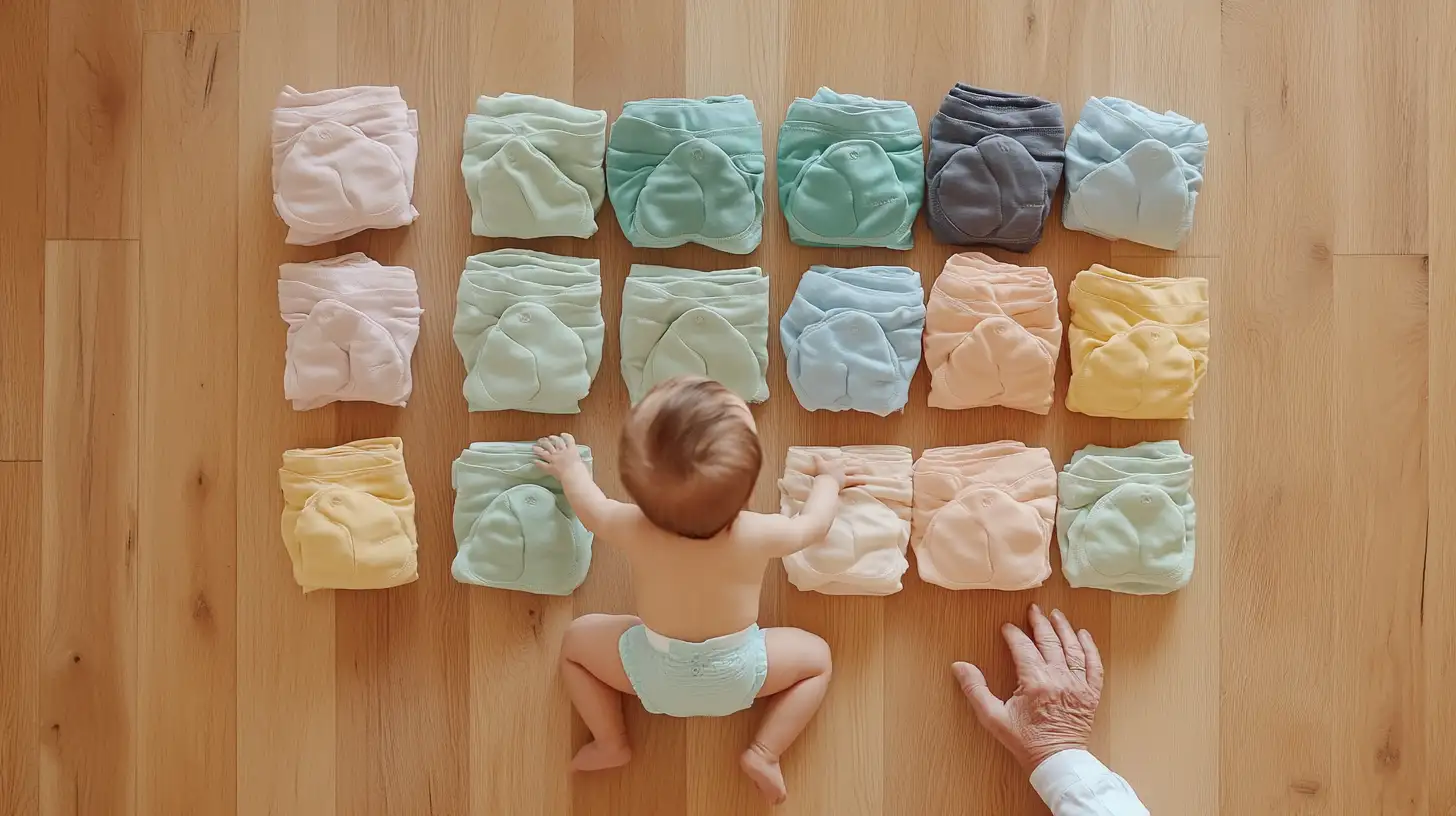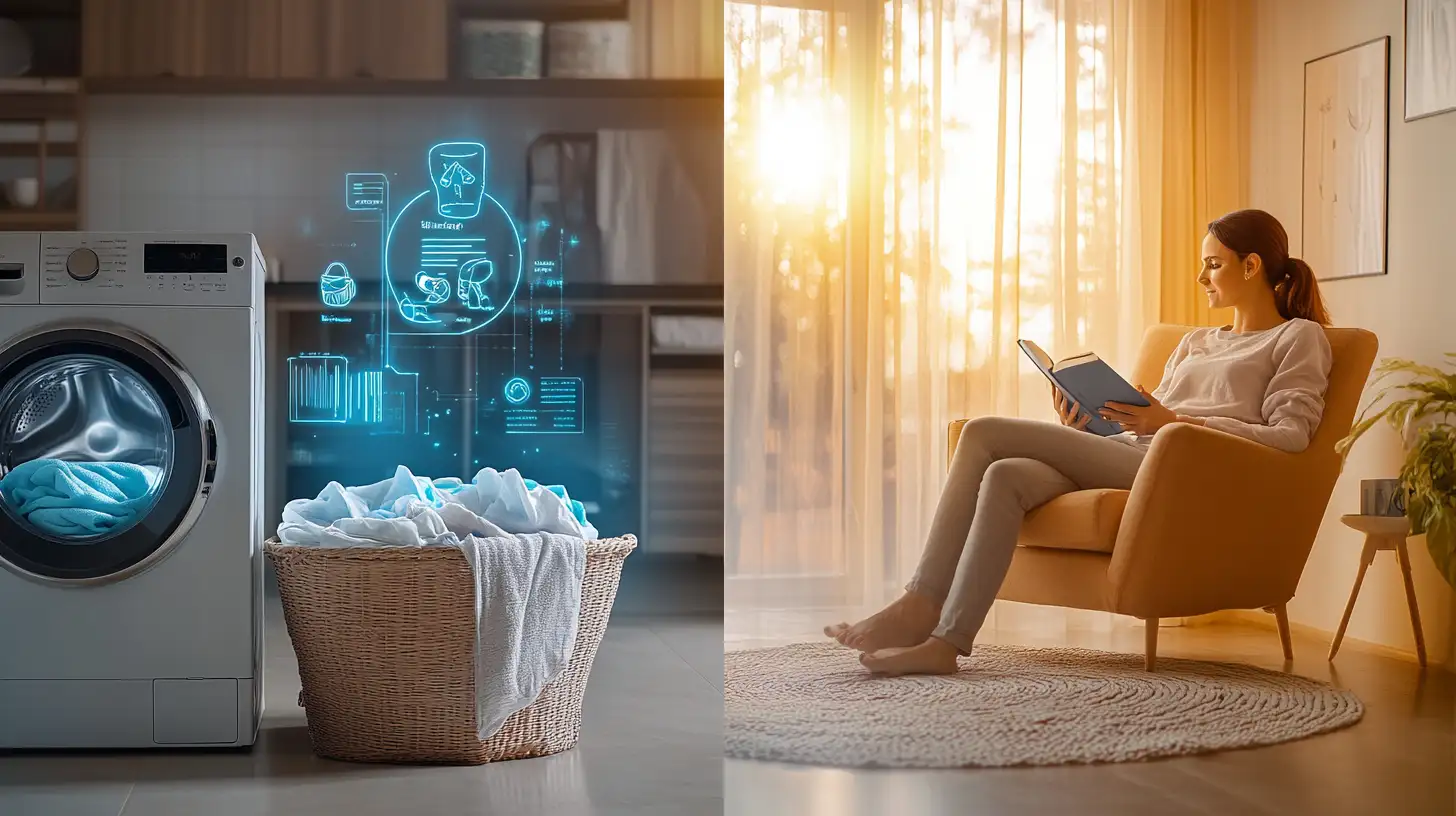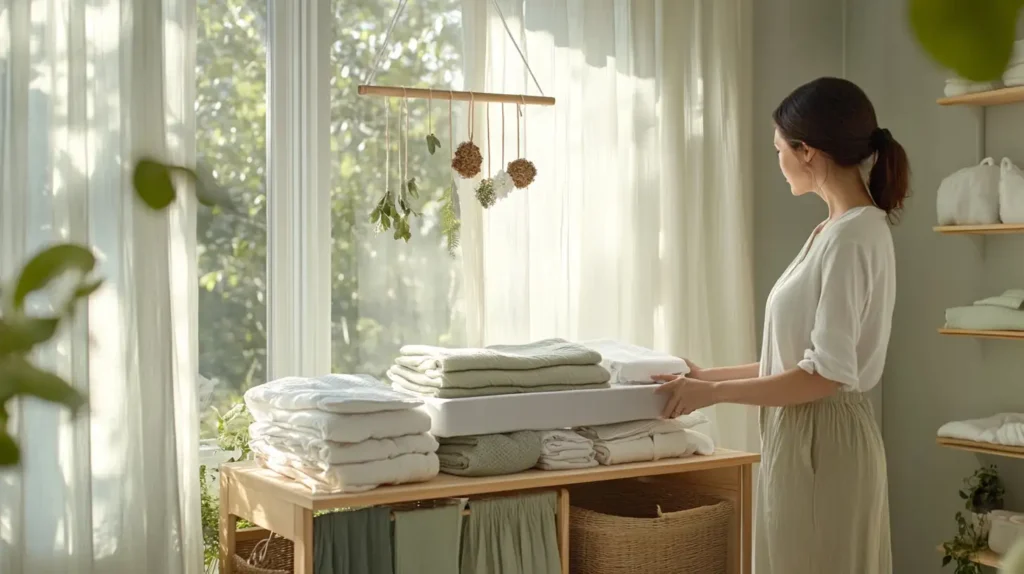Table of Contents
ToggleDitch the Disposables: Your 7-Minute Guide to Stress-Free Cloth Diapering
This may sound crazy, but the way to succeed with cloth diapering isn’t what you think. Have you ever felt that the more you researched cloth diapering, the more complicated and overwhelming it seemed? Maybe you’ve been scrolling through endless Instagram posts of perfectly organized changing stations, or watching YouTube videos of elaborate washing routines that seem to require a PhD in laundry science.
In this article, I’m going to share with you something I really wish I learned sooner about cloth diapering – and I actually shared this with a friend over coffee last week when she asked for my parenting advice. She so badly wanted to be more eco-conscious with her new baby but felt paralyzed by all the information, options, and the fear of failing at yet another parenting challenge.
I used to overthink everything about cloth diapering. Every diaper change, every washing routine, every nighttime solution. And I thought if I just cared more about getting things perfect – about following every rule, about avoiding every possible mistake – I’d be successful. But in reality, caring too much was just holding me back from actually starting.
So I made a change in my approach, and it made me more confident and actually able to stick with cloth diapering through two children, while working full-time and maintaining my sanity. I stopped caring about having the perfect system. I stopped caring about following every single recommendation to the letter. I stopped caring about what the cloth diaper experts might think of my methods.
And really, this changed everything. Because I think here’s the biggest mistake most new cloth diapering parents make: We think by caring deeply and researching endlessly, that will make things work out perfectly. We believe if we just want to be successful badly enough and hustle harder with our laundry routine, it will all be fine.
But what if I told you that the secret to cloth diapering success is actually caring less about doing it perfectly? Let’s jump in and I’ll show you how.

Simplify Your Stash: The Only Cloth Diapers You Actually Need
When I first started researching cloth diapers, I got lost in a sea of terminology – prefolds, flats, pockets, AIOs, fitteds, covers, inserts, boosters… it was like learning a new language. I thought I needed one of everything just to get started, and my virtual shopping cart kept growing to frightening proportions.
But here’s the truth I discovered after spending way too much money: most families end up preferring just one or two types of cloth diapers for daily use. The rest sit forgotten in drawers, barely used and definitely not worth the investment.
So let me make this simple for you. Start with just 12-18 diapers of ONE type. That’s it. For busy parents, I recommend either:
- Pocket diapers: These have a waterproof outer layer and a pocket you stuff with absorbent inserts. They’re adjustable, easy for caregivers to use, and dry quickly.
- All-in-ones (AIOs): These are most similar to disposables – one piece with everything sewn together. They’re the simplest to use but take longer to dry.
My grandmother back in Trinidad used simple flour sack cloths with safety pins and plastic pants for all nine of her children. While I appreciate modern innovations, her approach reminds me that humans have been successfully cloth diapering for generations without complications.
If you’re feeling overwhelmed by brands, just pick ONE reputable brand and stick with it to start. You can always expand your collection later when you know what works for your baby and your lifestyle.
Remember this: the perfect cloth diaper is the one that you’ll actually use consistently. Everything else is just noise.

The No-Stress Washing Method That Actually Works
I used to treat washing cloth diapers like some kind of sacred ritual. I’d stress about water temperature, detergent measurements, extra rinses, line drying versus machine drying, and whether the planets were properly aligned before pressing the start button.
And you know what? My diapers still occasionally had issues. Because sometimes, that happens no matter what you do.
So here’s my simplified, real-world washing routine that has worked through two babies, numerous daycare mishaps, and even a cross-country move with different water types:
- Store dirty diapers in a simple open-top hamper with a washable liner (no fancy diaper pail needed)
- Wash every 2-3 days (not letting them sit longer than that)
- Do a quick rinse cycle first with cold water, no detergent
- Then do a normal hot wash with the manufacturer’s recommended amount of regular detergent
- Dry inserts in the dryer, hang covers to air dry (if you have time), or just throw it all in the dryer on medium heat if you’re busy
That’s it. No special detergents. No complicated cycles. No elaborate pre-treatments.
If you’re dealing with particularly hard or soft water, you might need to adjust your detergent amount slightly, but start with this basic routine and only make changes if you actually encounter problems.
The freedom from overthinking this process will change everything for you. When you’re no longer obsessing over every little laundering detail, you move differently and show up differently as a parent. You become calmer, more present, and much more powerful in your parenting journey overall. And ironically, that’s when cloth diapering starts to feel effortless.

Hybrid Systems: The Secret Weapon for Modern Parents
Now, let me tell you about something that completely transformed my cloth diapering experience – the hybrid approach. This isn’t about being careless about your environmental goals. It’s about being free to detach yourself from an all-or-nothing mindset.
Imagine how you’d feel to be free from anxiety, free from overthinking, free from the fear of failing at cloth diapering. Because here’s the thing – you don’t have to choose between cloth diapers OR disposables. You can create a system that works for YOUR life.
My hybrid approach looked like this:
- Cloth diapers at home during regular days
- Disposable inserts in cloth covers for outings (less bulky to pack)
- Disposables overnight once my heavy wetter started sleeping longer stretches
- Disposables during stomach bugs or severe diaper rash
- Disposables when traveling more than a weekend
Some cloth diaper covers are specifically designed to work with either cloth or disposable inserts. Brands like GroVia, Flip, and Charlie Banana offer this flexibility, which is perfect for daycare situations where staff might be more comfortable with something closer to disposables.
We get so caught up in this idea that we have to be cloth diaper purists to make a difference. But using cloth diapers even part-time has a significant environmental impact. If the average baby uses about 7,000 disposable diapers before potty training, even using cloth 50% of the time keeps 3,500 diapers out of landfills!
The best cloth diapering parents I know – they care, but they’re not attached to perfection. They use cloth when it works, they use disposables when needed, and they don’t beat themselves up either way. Because they know if they’ve done what they can within the context of their real lives, they’ve already won.
And so have you.

The Real Cost Equation: Saving Money Without Losing Your Mind
I’m a perfectionist by nature. And if you are too, shout out to all the perfectionists out there who’ve created detailed spreadsheets comparing the costs of different diapering approaches. I see you, and I was you.
What I learned about overcoming my perfectionism in cloth diapering is that perfectionism isn’t about trying to save every possible penny – it’s about never feeling like you’re doing enough. So for me to overcome this, I had to understand and fully embrace what truly mattered in my cloth diapering journey.
Let’s talk real numbers:
- A basic cloth diaper stash costs approximately $300-500 upfront
- Laundry costs add about $15-20 per month for water, electricity, and detergent
- Disposable diapers cost roughly $70-100 per month
Over 2.5 years of diapering, cloth can save you around $1,500-2,000 per child. And if you use them for multiple children, the savings multiply.
But here’s what those calculations don’t show: the hidden costs of stress, time management, and mental load if you’re forcing a system that doesn’t work for your life. There’s no spreadsheet column for parent’s sanity.
When I stopped procrastinating on accepting what worked for MY family versus what the online cloth diaper gurus said should work, everything changed. We ended up with a system that was maybe 80% as cost-effective as it could have been if we followed every money-saving recommendation, but it was 100% sustainable for our lifestyle.
Because here is the most powerful thing in this journey: when you embrace your progress as a parent versus trying to achieve some perfect result that you imagined, you will achieve more than you ever thought possible. Knowing that what you have is enough, and that you are enough as a parent.
Taking that next step forward without knowing exactly how it will end, but really just trusting in the process – that is the secret to success in cloth diapering and honestly, in parenting as a whole.

Troubleshooting Without Tears: Simple Solutions to Common Problems
This fear of judgment and rejection from others when your cloth diapering journey isn’t Instagram-perfect – these are really just stories that you’re telling yourself. Because at the end of the day, people who matter in your life won’t mind if you’re struggling with leaks or if you occasionally use disposables. And for the people who mind? They don’t matter. Not in your parenting journey.
So why waste another moment living for someone else’s approval? Why not build a diapering approach that actually works for your family? The one that aligns with your values, your goals, and your version of what success means to you.
Here are the simple solutions to the most common cloth diapering challenges:
- Leaks: Add more absorbency (not more bulk). Double up inserts where baby sleeps and in the front for boys or back for girls.
- Smell: Check your detergent amount (usually needs to be more than you think) and make sure diapers aren’t sitting wet for days.
- Rashes: Change more frequently and give baby some diaper-free time daily. Use cloth-safe cream like coconut oil or zinc oxide without petroleum.
- Daycare resistance: Provide pre-stuffed pocket diapers that work just like disposables or use hybrid inserts.
- Partner hesitation: Make it easy – set up simple systems that don’t require special knowledge. Color-code inserts by absorbency level if needed.
Remember, my grandmother raised nine babies with simple cloth squares, and none of them had lasting trauma from the occasional leak or rash. This generation will be fine too.
The biggest troubleshooting tip I can offer is this: when something isn’t working, make ONE change at a time. Don’t overhaul your entire system at once, or you won’t know what actually solved the problem.
Your Diapering Freedom Plan
Wherever you’re reading this article, I want you to have the courage, clarity, and power to create a cloth diapering approach that works on your terms. Because you become powerful when you stop caring about the wrong things – like what the cloth diaper experts on social media think – and you become unstoppable when you create systems that actually fit your real life.
Here’s your freedom plan to get started today:
- Start small – Begin with just 12 diapers of one type and build from there once you know what works
- Embrace the 80/20 rule – Using cloth diapers 80% of the time is still a massive win
- Simplify your routine – The basic wash routine I outlined works for most families
- Create backup plans – Have disposables on hand for challenging times
- Find your people – Connect with other cloth diapering parents who share your practical mindset
If you’ve given cloth diapering your honest effort, if you’ve tried your best to make it work within the context of your real life with its real constraints and challenges, then you have already won – regardless of whether you use cloth 100% of the time or just a few days a week.
The true measure of success isn’t how perfectly you follow someone else’s cloth diapering rules. It’s creating a sustainable approach that works for your unique family while still making a positive impact on the planet. That’s the balance we’re all seeking, and it’s absolutely within your reach.
Thank you so much for being here. If you liked this article, you might also enjoy my upcoming piece about how one simple mindset shift changed how I approach all aspects of parenting – from feeding to sleep to play. I look forward to connecting with you in the next article.
Beyond her professional achievements, Jessica is also a successful mother to a large and thriving family. Her firsthand experience in balancing financial responsibilities while raising multiple children gives her a unique perspective that resonates with her audience. As a mother, Jessica understands the financial challenges and pressures faced by families, and she brings a compassionate and relatable approach to her blogging. Through her blog, Jessica not only shares her financial expertise but also provides invaluable insights on how to foster financial well-being while building a strong and harmonious family foundation. Whether it's budgeting, saving for college, or teaching children about money, Jessica's relatable stories and practical tips make her an indispensable guide for individuals striving to achieve financial stability while nurturing a fulfilling family life.
- Baby-Friendly Home Adaptations: No Renovation Required - September 26, 2025
- The Real Cost of Baby’s First Year: Budget Breakdown - September 15, 2025
- Childcare Costs vs. Career Breaks: Financial Decision-Making - September 3, 2025



